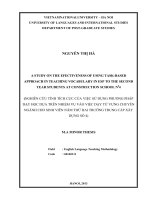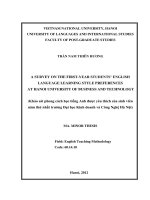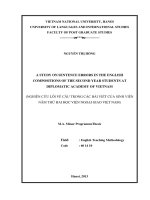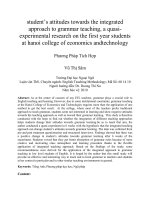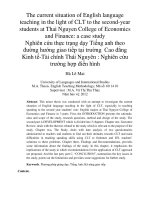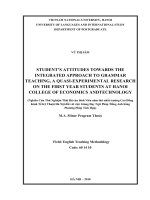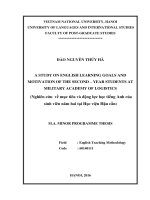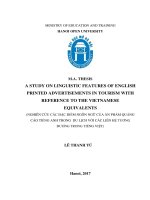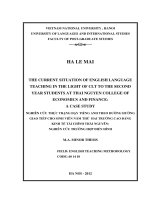A study on the effectiveness of using task-based approach in teaching vocabulary in ESP to the second year students at Construction School N04
Bạn đang xem bản rút gọn của tài liệu. Xem và tải ngay bản đầy đủ của tài liệu tại đây (2.01 MB, 102 trang )
VIETNAMNATIONALUNIVERSITY – HA NOI
UNIVERSITY OF LANGUAGES AND INTERNATIONAL STUDIES
DEPARTMENT OF POST-GRADUATE STUDIES
NGUYỄN THỊ HÀ
A STUDY ON THE EFECTIVENESS OF USING TASK-BASED
APPROACH IN TEACHING VOCABULARY IN ESP TO THE SECOND
YEAR STUDENTS AT CONSTRUCTION SCHOOL N
0
4
(NGHIÊN CỨU TÍNH TÍCH CỰC CỦA VIỆC SỬ DỤNG PHƢƠNG PHÁP
DẠY HỌC DỰA TRÊN NHIỆM VỤ VÀO VIỆC DẠY TỪ VỰNG CHUYÊN
NGÀNH CHO SINH VIÊN NĂM THỨ HAI TRƢỜNG TRUNG CẤP XÂY
DỰNG SỐ 4)
M.A MINOR THESIS
Field : English Language Teaching Methodology
Code : 60140111
HANOI, 2013
VIETNAMNATIONALUNIVERSITY – HA NOI
UNIVERSITY OF LANGUAGES AND INTERNATIONAL STUDIES
DEPARTMENT OF POST-GRADUATE STUDIES
NGUYỄN THỊ HÀ
A STUDY ON THE EFECTIVENESS OF USING TASK-BASED
APPROACH IN TEACHING VOCABULARY IN ESP TO THE SECOND
YEAR STUDENTS AT CONSTRUCTION SCHOOL N
0
4
(NGHIÊN CỨU TÍNH TÍCH CỰC CỦA VIỆC SỬ DỤNG PHƢƠNG PHÁP
DẠY HỌC DỰA TRÊN NHIỆM VỤ VÀO VIỆC DẠY TỪ VỰNG CHUYÊN
NGÀNH CHO SINH VIÊN NĂM THỨ HAI TRƢỜNG TRUNG CẤP XÂY
DỰNG SỐ 4)
M.A MINOR THESIS
Field : English Language Teaching Methodology
Code : 60140111
Supervisor : Dr. Phm Th Thanh Thy
HANOI, 2013
i
DECLARATION
This paper is submitted in partial fulfillment of the requirements for the degree of
Master of Arts at Department of Post Graduate studies – University of Languages and
International Studies-Vietnam National University. I certify that this thesis is the result
of my own research, and it has not been submitted for any other degrees.
Hanoi, November 2013
Student‟s signature
Nguyễn Thị Hà
ii
ACKNOWLEDGEMENTS
I am grateful to all the people who have helped me with this research study.
My thanks to:
My supervisor - Dr. Pham Thi Thanh Thuy, whose expert help and guidance
has been invaluable to me throughout the writing of this thesis.
The teachers of the Postgraduate Department - College of Foreign
Languages - Vietnam National University for the knowledge they have provided.
The three teachers of English and 50- second-year students at Construction
School N
0
4 for their assistance and participation in my experimental research.
Lastly, my thanks go to my family members, friends and other colleagues at
Construction School N
0
4 for their love and support to me, which are very
significant for me to finish this research study.
iii
ABSTRACT
This thesis is devoted to examining the comparative effectiveness of task-based
approach in teaching ESP vocabulary to second year non-major students at
Construction School N
0
4. In order to achieve this objective, a theoretical and practical
research is carried out. In the Theoretical Background, the background of vocabulary
and relevance to teaching vocabulary is summarized. An overview on task-based
approach that has been employing in foreign language teaching, especially in teaching
ESP vocabulary is also introduced in this part. After that, a brief background setting to
the quasi-experiment relating to teaching and learning ESP vocabulary at Construction
School N
0
4 is highlighted. Subsequently, the quasi-experimental study is given to
evaluate the effectiveness of task-based approach. And the results we will get based on
data analysis are in the third chapter. Finally, some recommendations for ESP
vocabulary teaching/learning effectively are suggested.
iv
LIST OF ABBREVIATIONS
ESP: English for Specific Purpose
EGP: English for General English
CG: Control group
EG: Experimental group
v
LIST OF TABLES
Table 1: The results of the post-tests of EGP part
Table 2: The results of the post-tests of ESP part
Table 3: The results of vocabulary-checking tests
vi
LIST OF CHARTS
Chart 1: Below-average
Chart 2: Average
Chart 3: Good
Chart 4: Excellent
Chart 5: Below-average
Chart 6: Average
Chart 7: Good
Chart 8: Excellent
vii
TABLE OF CONTENTS
DECLARATION i
ACKNOWLEDGEMENTS ii
ABSTRACT iii
LIST OF ABBREVIATIONS iv
LIST OF TABLES v
LIST OF CHARTS vi
PART I: INTRODUCTION……………………………………………………… 1
1. Rationale ………………………………………………………………… 1
2. Aims of the study………………………………………………………… 1
3. Significance of the study…………………………………………………. 2
4. Scope of the study……………………………………………………… 2
5. Research Questions………………………………………………………. 3
6. Methods of the study…………………………………………………… 3
7. Design of the study………………………………………………………. 4
PART II: DEVELOPMENT…………………………………………………… 5
CHAPTER 1: THEORETICAL BACKGROUND……………………… 5
1.1. An overview of vocabulary……………………………………………. 5
1.1.1. Definition…………………………………………………… 5
1.1.2. The importance of vocabulary……………………………… 5
1.2. English for Specific Purposes (ESP) and vocabulary in ESP…………. 6
1.2.1. English for Specific Purposes (ESP)………………………….
1.2.2. Vocabulary in ESP 7
1.3. Teaching vocabulary…………………………………………………… 8
1.3.1. Purposes for teaching vocabulary…………………………… 8
1.3.2. Principles of teaching vocabulary…………………………… 9
1.3.3. Stages in teaching vocabulary………………………………… 9
1.3.4. Techniques in teaching vocabulary…………………………… 10
1.3.5. Teaching vocabulary in ESP………………………………… 12
1.4. Task-based language teaching…………………………………………. 13
1.4.1. Task-based language teaching……………………………… 13
viii
1.4.2. Task-based language teaching in ESP context……………… 17
CHAPTER 2: THE QUASI-EXPERIMENT……………………………. 19
2.1. Background to the study……………………………………………… 19
2.1.1. The teachers………………………………………………… 19
2.1.2. The students………………………………………………… 19
2.1.3. The textbooks…………………………………………………. 19
2.1.4. The attitudes of teachers and students at Construction School N04 about the
importance of ESP vocablary teaching 20
2.1.5. The real situation of teaching vocabulary in ESP at Construction School N04 21
2.2. The quasi-experiment………………………………………………… 21
2.2.1. Subjects and process of vocabulary teaching…………………. 21
2.2.2. Main testing instruments: Pre-test and post-tests…………… 22
2.2.3. Supplementary testing instruments…………………………… 22
CHAPTER 3: DATA ANALYSIS, RESUTLS AND DISCUSSIONS… 24
3.1. Class observation result……………………………………………… 24
3.2. Teacher‟s self-assessment result……………………………………… 25
3.3. The post-tests result……………………………………………………. 25
3.4. Vocabulary-checking test result……………………………………… 29
PART III: CONCLUSION 33
REFERENCES 34
APPENDICES I
1
PART I: INTRODUCTION
1. Rationale
Teaching vocabulary especially in ESP courses is becoming a challenge for
English Language Teachers. As far as we know, vocabulary is an inseparable part of
any teaching syllabus and vocabulary should be taught in a well-planned and regular
basis. It‟s essential to carefully decide what vocabulary will be selected for teaching,
and what approach or activities will be used to teach it to the students. Although
English teachers in Vietnam are now being trained in using modern methods of
English teaching and attend local and international conferences, it is the fact that most
teachers at Construction School N
0
4 still use grammar-translation method to teach
vocabulary. That is, when the students begin a lesson, the teacher will first have the
students say the new words once, and then pay attention to the meaning of the words
in their native language. Following this, the students will go through the conversation
or reading passage while their teacher points out in the students‟ native language the
meaning of the passage as well as grammatical patterns that the students must know.
This type of teaching method is called the grammar-translation method which is not an
effective and suitable method in teaching vocabulary nowadays.
Meanwhile, task-based approach which has been strongly advocated and
promoted by many world-leading linguists (Prabhu 1987, Nunan 1989, Willis 1996,
Skehan 1998) since early 1980s is commonly used in language instruction to provide a
meaningful learning process for learners. It‟s closed affiliation with Communicative
Language Teaching (CLT) method provides a production focus in a more structural
framework in language learning process. Using task-based approach, each student can
get the same opportunity to experience the learning process by putting him/her in a
situation in which she/he can decide alone; mainly, the way of expressing and
accepting experience of using the target language. Hence, in this study the researcher
wants to explore whether task-based approach is effective or not in teaching
vocabulary in ESP to the second year students at Construction School N
0
4.
2. Aims of the study
As such, the study is aimed to: firstly, explore the attitudes of teachers and
students at Construction School N
0
4 about the importance of ESP vocabulary teaching;
secondly, study the real situation of teaching vocabulary in ESP and thirdly, test
2
whether task-based approach is effective or not in teaching vocabulary in ESP at
Construction School N
0
4 and finally give some suggestions for teaching vocabulary in
ESP.
3. Significance of the study
Because of the importance of vocabulary in ESP, it is necessary to find out
effective ways to teach vocabulary to the students. While modern methods has been
supported and promoted, a lot of teachers still use tradition ways, which make the
lessons boring. The study, thus, tries to test the effectiveness of task-based approach in
teaching vocabulary in ESP and suggest some recommendations for teaching
vocabulary in ESP more effectively.
With this study, the writer hopes to make a small contribution to
teaching/learning vocabulary in ESP effectively, which may help the students retain
vocabulary and the teachers find the most appropriate way in teaching ESP.
4. Scope of the study
Due to the limit of a minor thesis, the study just lasted 11- week exploration
basing on the three units (Unit 1, 2 and 3) of the textbook English for construction –
an in-house material used to teach at Construction School N
0
4. The participants in
this study are 50 students aging from 18-25 not randomly selected from K40-TXD1
and K40-TXD2 at Construction School N
0
4 in Xuan Hoa town, Phuc Yen district,
Vinh Phuc province. To ensure the relative equality of English knowledge level
between two classes, the researcher asked one teacher of English who has taken part
in teaching these two classes at school for help to choose students in each class with
the following criteria:
- 12 students getting good mark in the two latest semesters (from 7.0 to 8.0 mark) in
English for General Purposes (EGP)
- 13 students getting average mark in the two latest semesters (from 5.0 – 6.9 mark)
in EGP
These two classes were assigned randomly to two groups, namely a control group
(CG) and an experimental group (EG). Another teacher of English also took part in
the study with the role of preparing the lesson plan and teaching two groups -
experimental and control ones. The researcher herself could not teach the students,
because she has to work as an observer in the study.
3
5. Research Questions
For this study, four research questions are addressed:
1. What are attitudes of teachers and students at Construction School N
0
4 about the
importance of ESP vocabulary teaching?
2. What is the real situation of teaching vocabulary in ESP at Construction School
N
0
4?
3. How is task-based approach used in teaching vocabulary in ESP at Construction
School N
0
4?
4. What are some suggestions in teaching vocabulary in ESP for students of
Construction School N0 4?
6. Methods of the study
First of all, the Theoretical Background relating to the research was conducted
by collecting materials, internet sources. In the Development, the researcher took a
brief look at the reality of teaching vocabulary in ESP at Construction School N
0
4
including the descriptions of the teachers, students, textbook and method of teaching
vocabulary as the background setting to the study.
With an attempt to find out the effectiveness of task-based approach in teaching
vocabulary in ESP to second year students at Construction School N
0
4, a quasi-
experiment was carried out. 50 students from K40-TXD1 and K40-TXD2 were not
randomly selected. One class was randomly assigned as the experiment group and the
other as the control group. Another teacher of English took part in the study with the
role of preparing lesson plan and teaching both groups. The quasi-experiment lasted 11
weeks with three first units of the textbook - English for construction. The pre-test was
administered to the students of both classes at the beginning of the experiment in order
to check students‟ vocabulary knowledge. After finishing one unit, a post-test, whose
content was based on the knowledge of that unit was delivered to students of both
classes. However, the content of the last post-test included the knowledge of all three
units. Apart from the post-tests, class observation, teacher‟s self-assessment and
vocabulary-checking tests were used as supplementary testing instruments to confirm
the post-test results. The data obtained were thoroughly analyzed by statistical
descriptions. By these ways, we can test whether task-based approach was really
effective in teaching vocabulary in ESP.
4
7. Design of the study
The research includes three parts. The first part is Introduction, in which the
rationale, aims, scope, methods, research questions and design are identified.
The second one is Development which consists of three chapters. Chapter 1 -
Theoretical Background gives an overview of the theories relating to teaching
vocabulary in ESP. In the chapter 2 - The Quasi-Experiment, the researcher
describes the background to the study; how to carry out and the process of
conducting the quasi-experiment. The last chapter - chapter 3 - Data analysis,
results and discussion prescribed the results of the quasi-experiment.
The part 3 – Conclusion, gives the summary of the study, the suggestions for
teaching/learning more effectively and the recommendations for further study.
5
PART II:
DEVELOPMENT
CHAPTER 1: THEORETICAL BACKGROUND
1.1. An overview of vocabulary
1.1.1. Definition
Hornby (1995) defines vocabulary is the total number of words in a language.
Yet vocabulary is much more than just single words. Recent vocabulary studies draw
on an understanding of lexis, the Greek for word, which in English “refers to all the
words in a language, the entire vocabulary of a language” (Barcroft, Sunderman, &
Schmitt, 2011, p. 571). So it will probably not surprise you to learn that vocabulary
also includes lexical chunks, phrases of two or more words, such as Good morning and
Nice to meet you, which research suggests children and adults learn as single lexical
units. Phrases like these involve more than one word but have a clear, formulaic usage
and make up a significant portion of spoken or written English language usage. Also
called formulaic sequences (Alali & Schmitt, 2012), they are central to English
vocabulary learning and therefore worth teachers‟ attention as they teach vocabulary
(Lewis, 1993).
Therefore, vocabulary can be defined as the words of a language, including
single items and phrases or chunks of several words which covey a particular meaning,
the way individual words do.
1.1.2. The importance of vocabulary
Regarding the important roles of vocabulary in language learning and teaching,
Wilkins (1972, p.111) stressed that “without grammar very little can be conveyed,
without vocabulary, nothing can be conveyed”. According to Richards and Renandya
(2002), "vocabulary is a core component of language proficiency and provides much
of the basis for how well learners speak, listen, read, and write" (Richards &
Renandya, 2002, p. 255). As such, by having many stocks of words learners will be
able to comprehend the reading materials, catch other talking, give response, speak
fluently and write some kind of topics. On the contrary, if the learners do not
recognize the meanings of words used by those who address them, they will be unable
to participate in conversations, unable to express some ideas, or unable to ask for
information. Obviously, vocabulary is considered an important aspect of learning and
6
teaching a foreign language that researchers, teachers, and learners have paid a lot
attention to. To emphasize this, Chanier and Selva also states that vocabulary
knowledge is a key factor in reading comprehension (1998: 489, as cited in
Constantinescu, 2007). As what Thornbury states in the book titled How to teach
vocabulary, grammar is a collection of rules while vocabulary is a collection of items
and “one rule can generate a great many sentences”, which to some extents implicates
that “vocabulary learning never stops, even long after grammar system is firmly in
place, new words are being coined daily and old words is assuming new meaning” or
in other words, the grammar learning could be mastered at some level whereas
mastering vocabulary seem to take more time than that.
1.2. English for Specific Purposes (ESP) and vocabulary in ESP
1.2.1. English for Specific Purposes (ESP)
The study of Language for Specific Purposes (LSP) has a long and valid history
(Streven, 1977; cited in Johns & Dudly-Evans, 1998). Especially today since the focus
of research is upon English, English for specific purposes has gained ascendency in
different fields (Johns & Dudley-Evans, 1998). "ESP has been referred to as applied
ELT as the content and aim of any course is determined by needs of a specific group
of learners" (Dudly-Evans, 1998). Howatt (1984) introduces ESP as an innovative
activity in the domain of language teaching. Strevans (1988; cited in Dudly-Evans and
St John, 1998, p. 3) defines ESP in terms of four absolute characteristics and two
variable characteristics. The absolute characteristics are that ESP consists of English
Language Teaching which is
designed to meet the specified needs of the learner;
related in content ( that is in its themes and topics) to particular disciplines,
occupations and activities;
centered on language appropriate to those activities in syntax, lexis, discourse,
semantic and so on, and analysis of the discourse;
in contrast with 'general English'.
And the variable characteristics are that ESP
may be restricted as to the learning skills to be learned (for example reading only);
may not be taught according to any pre-ordained methodology
Later Dudly-Evans and St John (1998, p. 4) modified Strevens‟s definition in the
following way:
7
Absolute characteristics:
ESP is designed to meet specific the needs of the learners;
ESP makes use of underlying methodology and activities of the discipline it serves;
ESP is centered on the language appropriate to these activities in terms of grammar,
lexis, register, study skills, discourse and genre.
Variable characteristics:
ESP may be related to or designed for specific disciplines;
ESP may use, in specific teaching situations, a different methodology from that of
General English;
ESP is likely to be designed for intermediate or advanced students;
Most ESP courses assume some basic knowledge of the language systems.
Robinson (1991) believes that ESP is a major activity around the world today.
Huchinson and Waters (1987), make the point clear: ESP is not a matter of teaching
specialized varieties of English, nor is just matter of science words and grammar for
scientists. It is also not different in kind from any other form of language teaching as far
as principles of effective and efficient learning are concerned (p. 18).
1.2.2. Vocabulary in ESP
In terms of vocabulary in ESP, it is most important to make a distinction
between two types of vocabulary: technical and semi-technical because they are of
great importance to the learners studying English for specific and academic purposes.
Dudley-Evans and St John (1998, p. 83) suggest two broad areas related to technical
vocabulary.
(a) Vocabulary that is used in general language but has a higher frequency of
occurrence in specific and technical description and discussion;
(b) Vocabulary that has specialized and restricted meanings in certain disciplines and
which may vary in meaning across disciplines.
It is quite clear that the first area would be referred to as semi-technical and the
second area would be referred to as technical vocabulary.
According to Hutchinson and Waters (1987), ESP should be seen as an
approach to language teaching which is directed by specific and apparent reasons for
learning. Their specific and apparent reasons for learning English is for academic
purposes and their academic study will involve specialized areas across different
discipline in physical sciences as well as in social sciences. The aim of their
8
vocabulary acquisition is surely academic vocabulary. A rationale behind this is that
learners who will do academic study in English must focus on academic vocabulary
which is variously known as a general useful scientific vocabulary and semi-technical
vocabulary. It is because they need to exhibit a wide range of academic skills like
reading about research papers in their own fields, listening to teachers speak about
their work, writing academic papers and presenting oral or written evaluations of
methods or results in many cases (Farrell, 1990).
1.3. Teaching vocabulary
1.3.1. Purposes for teaching vocabulary
One reason teachers are concerned about teaching vocabulary is to facilitate the
comprehension of a text that students will be assigned to read. If students do not know
the meaning of many of the words that they will encounter in a text, their
comprehension of that selection is likely to be compromised. When the purpose of
vocabulary instruction is to facilitate the comprehension of a selection, it is obvious
that this instruction must take place as an introduction before the reading of the
selection.
As a rule, new words in narrative selections are not as critical to the overall
understanding of the selection as new words in informational selections. Before
guiding students‟ reading of a particular narrative, teacher should determine if there
are any new words that represent concepts that are critical to understanding the
selection and which are not adequately defined in context. If there are, then these
words should be presented and discussed before the students read. The exploration of
these prerequisite terms and concepts will establish a strong foundation for subsequent
learning.
A second major reason for teaching the meaning of words is to increase the
number of words that students know and can use in a variety of educational, social,
and eventually work-related areas. To increase the number of words the students learn,
it is often helpful to teach these words in morphological or semantic clusters. A very
effective way to present semantically related words is to build word webs around some
central concepts.
According to Thornbury (2002) “the acquisition of new words is the process
which never stops”. To build a good storage of vocabulary is the first and one of the
9
most important steps when starting to learn a new language. Therefore, it is essential to
teach students vocabulary.
1.3.2. Principles of teaching vocabulary
Kieran A. File has shared with English language teaching staff at the University
of Economics in Ho Chi Minh City six principles when they plan a direct vocabulary
teaching and learning program. The six principles are:
Choose useful words;
Let the learners do the work;
Focus on different aspects of a word;
Provide meaningful learning opportunities;
Implement a regular testing schedule;
Be patient with their learners.
According to Kieran A. File, these six principles are not the only principles for
vocabulary teaching and learning, but they offer teachers a good starting point for
decisions about the vocabulary they plan to spend time on in their classrooms.
In another study conducted by Erin Lowry (2009), he also gave six principles
which have some similar to those by Kieran A. File. These are:
Keep teaching simple and clear. No complicated explanations;
Relate present teaching to past knowledge by showing a pattern;
Use both oral and written presentation – write it on the board and explain;
Give most attention to words that are already partly known;
Tell the learners if it is a high frequency word that they should remember;
Don‟t bring in other unknown or little-known related words (like synonyms or
opposites).
Each researcher or scientist gives his/her own ideas of principles of teaching
vocabulary. By combining, following all these principles and putting them into
practice the teacher of language will have good and effective lessons of teaching
vocabulary.
1.3.3. Stages in teaching vocabulary
Basically as proposed by Gower (2005) and Thornbury (2002) there are three
stages in teaching vocabulary namely Presenting, Practicing and Revising.
Presenting vocabulary refers to pre-planned lesson stages in which learners are
taught pre-selected vocabulary items (Thornbury, 2002). To present new items it is
10
important to show the meaning of the words as well as the form in which it is used.
There are several ways to present new items, such as using translation, which is the
most direct route to a world‟s meaning, illustrate meaning using pictures, mime or
realia, appropriate to teach beginners; contextualizing, defining, giving synonyms,
opposites and giving detailed descriptions which are suitable for advanced learners.
After presenting the words, practicing of the words is necessary. To do that,
many different kinds of tasks could be implemented in order to move the words into
long term memory, the one a learner has to activate in order to retrieve the words when
necessary (Thornbury, 2002). Among these classroom activities teacher can use some
decision making ones like identifying, selecting, matching, sorting, ranking and
sequencing. And also production tasks, for instance, completion of sentences and texts
and creation of sentences and texts.
The last stage is related to the production stage with the aim of helping students
to incorporate the new items into the lexicon. This can be done by using
communicative activities in which the learners have to retrieve the vocabulary already
learnt and practiced.
1.3.4. Techniques in teaching vocabulary
Techniques in presenting vocabulary
The main aim of presenting vocabulary is to insert the meaning, the correct form
and appropriate usage of the new word into the student‟s memory. There are quite lots
of methods and techniques how to present the form and meaning of new lexical items.
It depends on teachers, which form of presentation is the most suitable for the
particular topic. According to Gairns and Redman (1986), there are some traditional
methods and techniques used to present new vocabulary:
Visual techniques:
Visuals – photographs, flashcards, blackboard drawings, pictures, videos, wall-charts,
pictograms and real objects; they are useful for teaching concrete words.
Demonstrating: mime/facial expression and gesture – useful for teaching action verbs.
Verbal techniques:
Illustrative situations (oral or written) – this technique is helpful when the words are
more abstract.
Synonyms and antonyms – using the words students have already known to teach
them similar words.
11
Definitions and explanations – appropriate for intermediate learners. To make
definition of words can be difficult, especially at elementary levels.
Scales – if students know 'big' and 'small', for example, other steps could be to teach
'short' and 'long' etc.
Examples of the type – give examples of words you want to introduce.
Translation – it has been the most widespread activity used for presenting the meaning
of a word in classes.
Guessing from the context, matching/labelling – learners match words to words or
sentences or pictures. It belongs to so called discovery techniques: they activate the
learner‟s previous knowledge of a language and initiate the work with the new
vocabulary. Discovering techniques demands the autonomous students with higher
knowledge of English.
Techniques in practicing vocabulary
Presenting a word in the class does not secure that it will be remembered for a long
time. There are many practice activities that include repeating of the new vocabulary
to fix the new words in the learners´ memory. The practice activities are divided into
two main groups: receptive and productive.
Receptive practice (the learner does not really produce the target words) includes
these types (Thornbury, 2002):
Identifying – means finding words in a text or listening, e.g. underline specific words
or expressions in the text, or tick, put in the correct column or list items that you hear.
Selecting – means recognizing words and making choices among them, e.g. circle the
odd word in the line.
Matching – includes recognizing words and than pairing them with their synonym,
antonym, definition, pictures to words etc. It can be intended to matching parts of
lexical items to create collocations (there is a very popular memory game based on
matching called Pelmanism).
Sorting – putting the lexical items into different categories, e.g. put these adjectives in
two groups – positive and negative.
Ranking and sequencing – putting the lexical items in some kind of order, e.g.
ordering items chronologically, ranking items according to personal preference etc.
Productive practice (the productive skills – writing or speaking – are incorporated
in the vocabulary teaching,) includes these types (Thornbury, 2002): completion and
creation.
12
Completion tasks (context is given), often called gap-fills, are widely used not only in
practice but also in revision stages. They include open gap-fills or closed gap-fills
(multiple choice activities), crosswords,
Creation tasks: the learner use the word in a sentence or a story, in writing, speaking
or both forms, use affixes to build new naming units from given words.
Techniques in revising vocabulary:
Vocabulary revision aims at helping students acquire active, productive
vocabularies. Students need to practice regularly what they have learnt; otherwise, the
material will fade away. Teachers can resort to many techniques for vocabulary
consolidation and revision. In this stage, some specific tasks are listed below:
Ordering
Rub out and remember
Networks
Bingo
Wordstorm
Slap the board
Guess the pictures
Matching
Noughts and crosses
What and where
Wordsquare
Jumbled words
As for Thornbury, those listed activities above are some common language
games which assist teachers in implementing a productive vocabulary lesson with
learners. The final stage, as further recommended by him, highly involves production
tasks in which learners, after having made decisions will actually produce something
as a product of their own. In this way, learners will turn words from receptive to
productive and put them into long-term memory (p.100)
1.3.5. Teaching vocabulary in ESP
Teaching vocabulary especially in ESP courses is becoming a challenge for
English Language Teachers. In other words, teaching technical terms to students is not
an easy task. Teachers always have to consider best methods and techniques of
teaching, characteristics of their students and vocabulary in students‟ specific field.
13
Taking into consideration the specific factors of ESP vocabulary teaching “many of
the techniques traditionally used in ELT work can be exploited in ESP vocabulary
teaching especially at the early stages when both subject and linguistic content are at
an elementary level” (Kennedy and Bolitho 59). Meanwhile, getting students to
involve tasks is one of some ways to put these techniques into practice, which means
the teacher applies task-based language teaching (TBLT)/ task-based approach.
However, TBLT haven‟t been applied at my school to teach vocabulary until now.
That is the reason why I want to study task-based approach and test its effectiveness in
teaching vocabulary in ESP at my school. Teaching vocabulary in ESP effectively
means the students can master the vocabulary their teacher teaches and use fluently
both in educational environment and in real world.
1.4. Task-based language teaching
1.4.1. Task-based language teaching
Task-based language teaching has increasingly achieved popularity in recent
years and has been recommended as a way forward in English Language Teaching.
According to Richards and Rodgers (2001), "task-based language teaching refers to an
approach based on the use of tasks as the core unit of planning and instruction in
language teaching" (p. 223). In task-based approach, learners concentrate on meaning
rather than form. That is, students carry out a group of communicative tasks instead of
form-based discrete exercises. Students are expected to express their own ideas, either
orally or in a written mode, about the topic of the lesson. These ideas should be based
on the analysis of meaning derived from a communicative activity.
Task-based language education starts from the basic idea that students learn a
language by performing tasks. A task is generally described as an activity in which
people engage to attain an objective, and which involves the meaningful use of
language. According to Willis (1996), tasks are always activities where the target
language is used by learners for a communication purpose in order to achieve an
outcome (p. 23). Furthermore, Willis presents a task-based approach where tasks are
used as the main focus of the lesson within a supportive framework. She holds that
“the aim of tasks is to create a real purpose for language use and to provide a natural
context for language study” (p. 1). Nunan (2004) defines a task as “a piece of
classroom work that involves learners in comprehending, manipulating, producing, or
14
interacting in the target language while their attention is focused on mobilizing their
grammatical knowledge in order to express meaning and in which the intention is to
convey meaning rather than to manipulate form” (p. 4). He believes that “task is an
important element in syllabus design, classroom teaching and learner assessment” (p.
1).
When it comes to the theory of learning, Richards and Rodgers (2001), propose
that “tasks provide both the input and the output processing necessary for language
acquisition”. “Task activity and achievement are motivational” (p.228). Meanwhile
motivation is a need for language learning. Brown (2000) argues that “it is easy in
second language learning to claim that a learner will be successful with the proper
motivation” (p. 160).
Besides the above definitions, Ellis (2003: 16) provides a composite one:
A task is a work-plan that requires learners to process language pragmatically in
order to achieve an outcome that can be evaluated in terms of whether the correct or
appropriate propositional content has been conveyed. To this end, it requires them to
give primary attention to meaning and to make use of their own linguistic resources,
although the design of the task may predispose them to choose particular forms. A task
is intended to result in language use that bears a resemblance, direct or indirect, to the
way language is used in the real world. Like other language activities, a task can
engage productive or receptive, and oral or written skills, and also various cognitive
processes.
An interesting aspect of this definition is that it includes almost all the major
points of contention in language pedagogy: attention to meaning, engagement with
grammar, inclusion of pragmatic properties, use of authentic communication,
importance of social interaction, integration of language skills, and the connection to
psycholinguistic processes.
Talking about types of tasks, there are numerous types of tasks. However, they
are, in general, are characterized as two main typologies: pedagogical tasks and target
tasks. Pedagogical tasks include any of a series of techniques designed ultimately to
teach students to perform the target task. Target tasks are much more specific and
more explicit related to classroom instruction. In nature, tasks are categorized as one-
way/two-way tasks, planned/unplanned tasks, close/open tasks, and
15
convergent/divergent tasks. For development of the practical work in this s Target
tasks are much more specific and more explicit related to classroom instruction. In
nature, tasks are categorized as one-way/two-way tasks, planned/unplanned tasks,
close/open tasks, and convergent/divergent tasks. For development of the practical
work in this study, the definitions of these tasks suggested by Long (1989) should be
taken into consideration:
One-way tasks refer to ones in which one person describes the information
which only he or she can see so that others can get it. For example,
describe one‟s own process of interviewing a number of people on their
daily life
Two-way tasks are the ones in which each member of a group has
exclusive access to information about the final result of a problem-solving
activity. An example could involve giving one person a version of a
picture, giving another version of the same picture to their partner, and
asking them to identify the difference between the two pictures.
Planned tasks are the ones that are prepared and planned in advance to
access their effects on written or oral work. For example, planning the
words, phrases and ideas before carrying out an interview.
Unplanned tasks: the ones that are not prepared and planned in advance
before accessing their effects on written or oral work. For example,
students are asked to have informal face-to-face conversations.
Convergent tasks include problem-solving through social interaction,
decision making, arrangement making, and information organizing through
conversation or correspondence.
Divergent tasks include topic discussion through the exchange of
information, ideas, opinions, attitudes, feelings, experiences and plans.
Lots of procedures and stages of task have been devised so far, but Ellis (2003)
believes that they all have in common three principal phases: pre-task, during task, and
post-task. In pre-task phase the overall purpose of this phase is to prepare the learners
for the next phase, that is, students should get prepared for completing the task. In fact,
the pre-task phase has two basic functions: 1) to introduce and create interest in doing
a task on the chosen topic, and 2) to activate topic-related words, phrases and target
sentences that will be useful in carrying out the task and in the real world
communication. In the during task phase, students work in pairs or groups although
